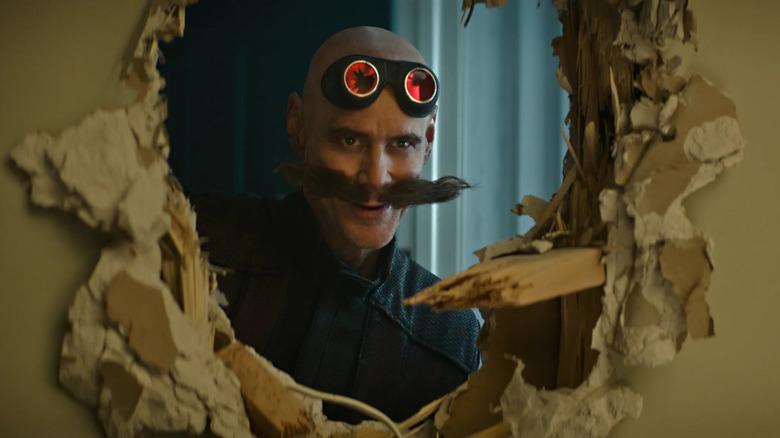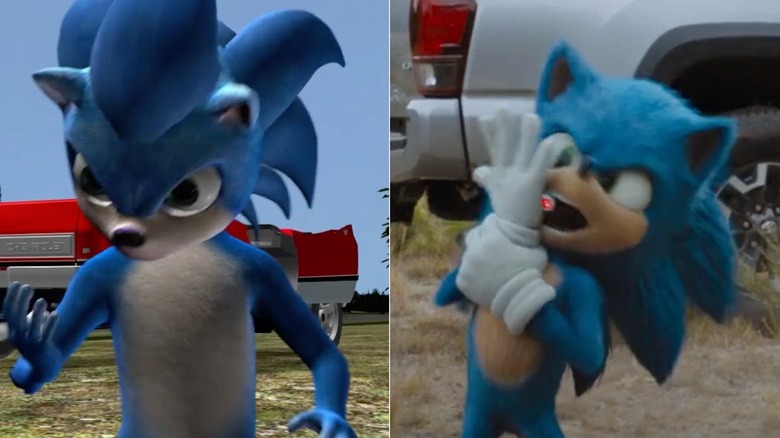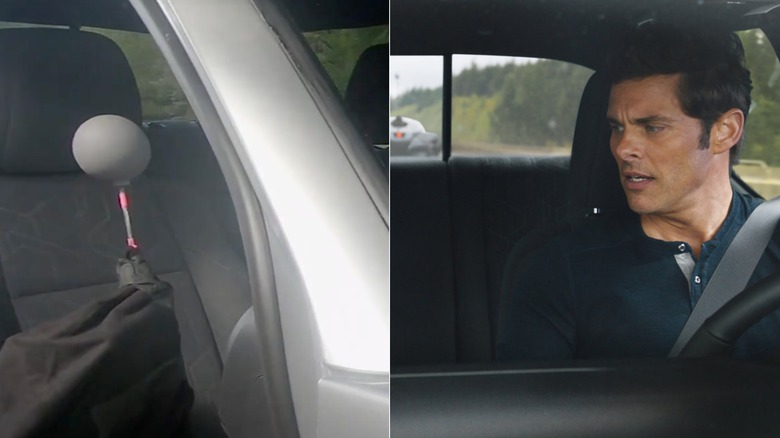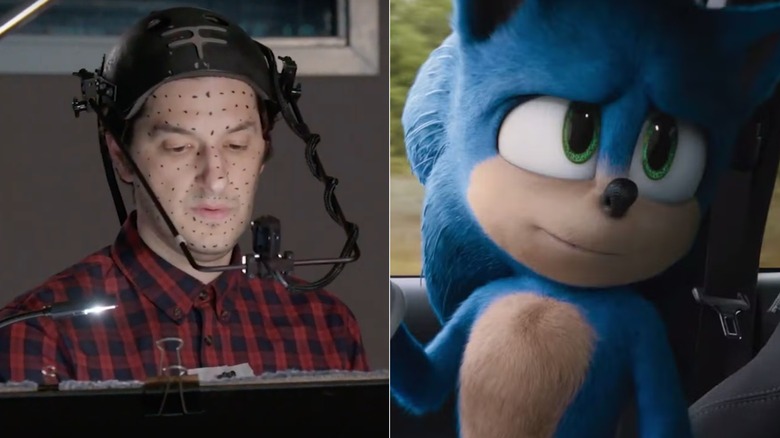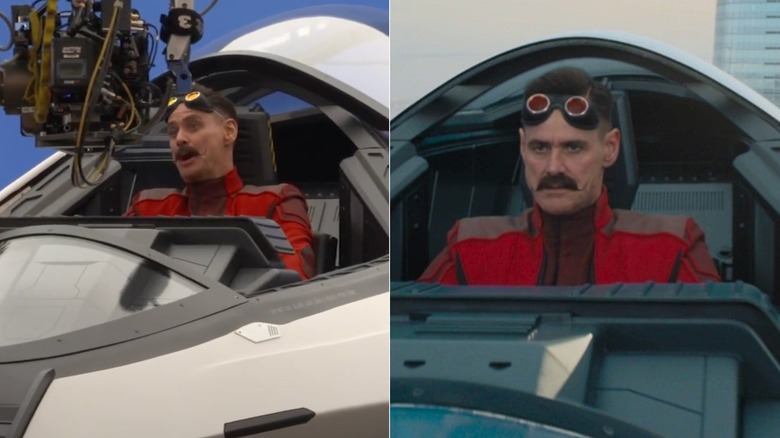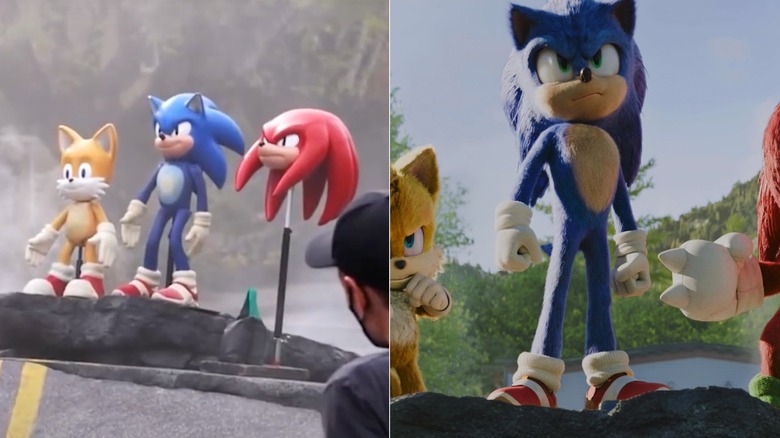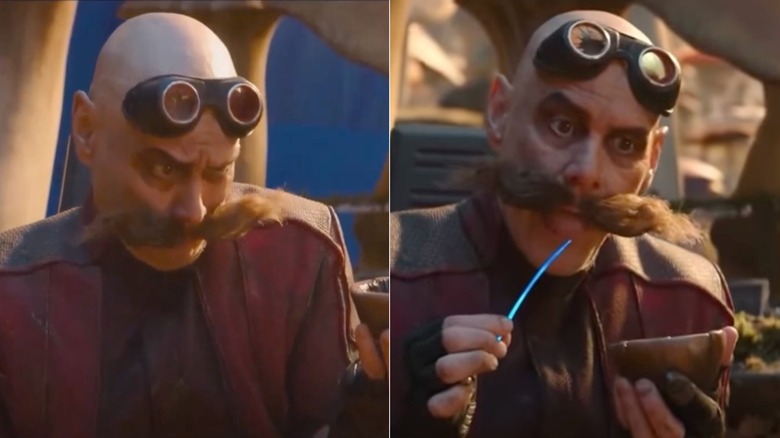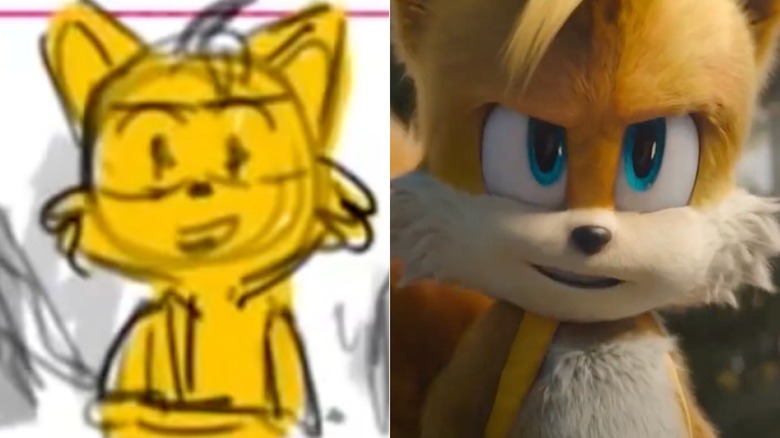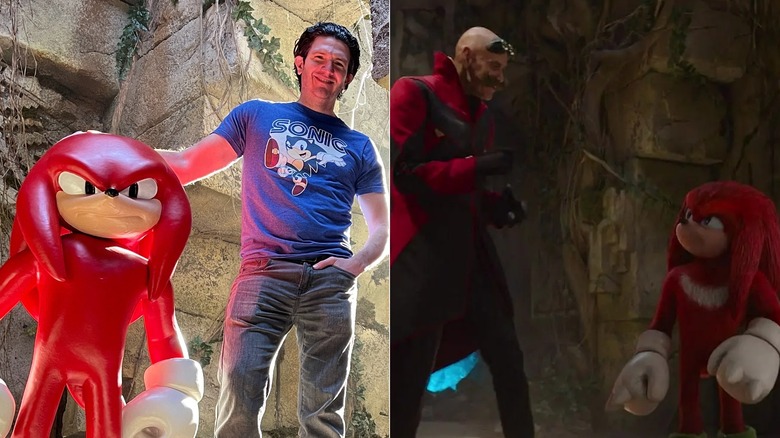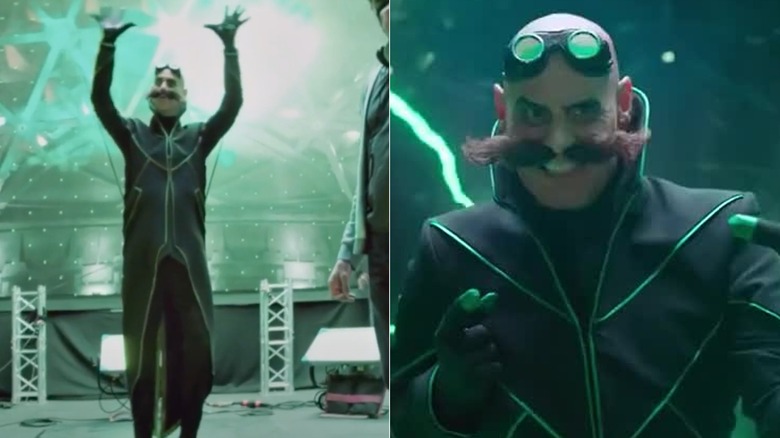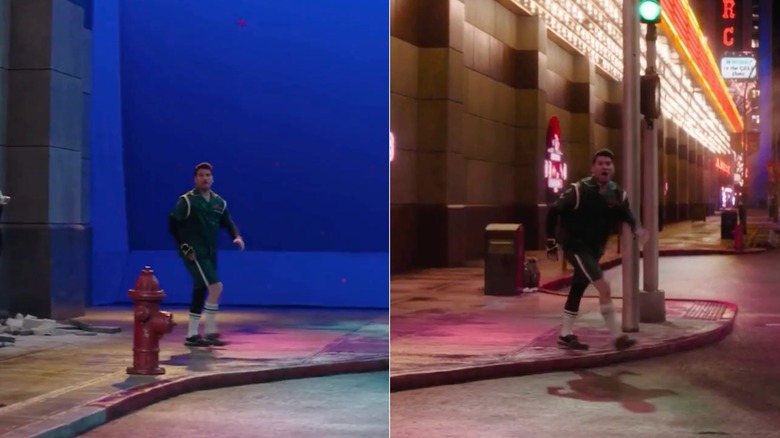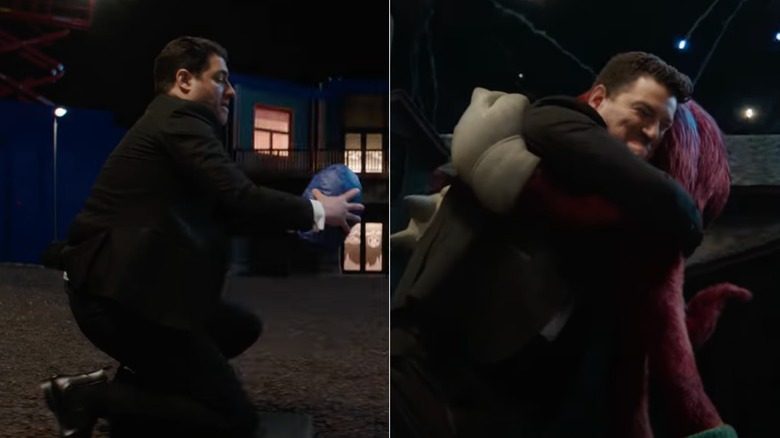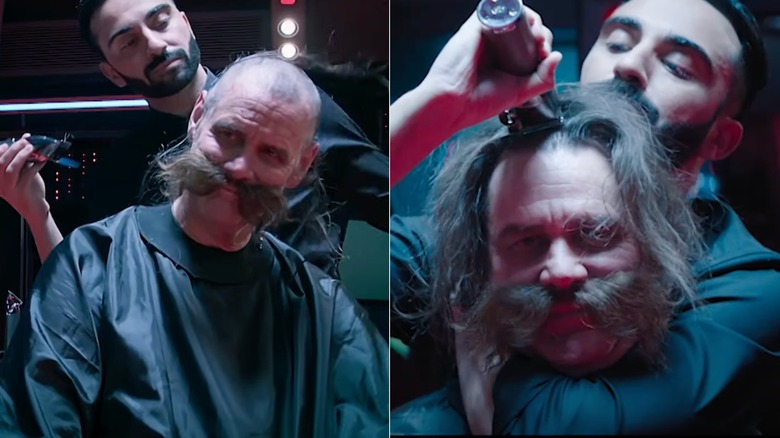What Sonic The Hedgehog Looks Like Without Special Effects
If you were to tell a "Sonic the Hedgehog" fan in 2019 that they'd be lining up to see the franchise's highly anticipated third film in theaters, they probably wouldn't believe you. The live-action video game adaptations got off to a rough start when the first trailer revealed a design for Sonic that, to put it gently, disappointed longtime fans. In a surprising move, director Jeff Fowler announced the film would be delayed three months to retool it, with Sonic's new design receiving praise, for better or worse.
Thankfully, the film franchise had a lot more riding on it than the CGI portrayal of its main character. The casting of Jim Carrey as Sonic's nemesis Dr. Robotnik seems to have saved the comedy actor's career from retirement, while the voice cast for familiar "Sonic the Hedgehog" figures includes Ben Schwartz as the blue blur himself, Idris Elba as a fully committed Knuckles the Echidna, and even Keanu Reeves as the newest film's antagonist, Shadow the Hedgehog.
Nevertheless, it takes a village of VFX professionals to make fans of Sonic see their childhood favorite become a live-action figure on the big screen. Many movie fans already know what films like "Deadpool & Wolverine" look like without special effects, but for a franchise like this, it can be harder to imagine how anthropomorphic, computer-generated heroes are brought to life.
The first movie utilized pre-visualization sequences
Like many modern-day movie productions, a lot of animation work is done well before a single camera starts rolling. Pre-visualization is a process that comprises storyboards, shot lists, and animatics to roughly depict how a given scene will look so the director and other departments can have a mutual understanding of the intended final product. For a film like "Sonic the Hedgehog," which has extensive use of CGI for its main character, "pre-vis" is an integral part of pre-production.
For visual effects artist Ellery Ortiz, these computer-generated storyboards are essential to laying the groundwork for a film's final animations. Ortiz's pre-vis reel is available to watch on Vimeo, giving an idea of just how intricate these prepared sequences can be. Among several scenes animated by Ortiz for "Sonic the Hedgehog" is the one where Sonic and Tom are in a car chase avoiding Dr. Robotnik's drones as well as moments of the final confrontation between Sonic and Robotnik, where our hero defeats the mad scientist.
As for the final scene, it's obvious to see a lot of changes between pre-visualization and the final cut, from slightly different camera angles to a much more expressive CGI performance from Sonic. However, these initial animations help people like Ben Schwartz, who told Den of Geek, "[When] I'm doing my performance, most of the time it's very pre-vis ... Some of them look like old school Sega Saturn type graphics."
James Marsden acted with several different stand-ins
James Marsden, who plays Tom, has yet to interact on-screen with a real-life talking hedgehog. However, it'd also be difficult to coordinate having the live-action actor in Vancouver, Canada, play opposite Ben Schwartz, who records his lines for Sonic separately over the course of many months. Luckily, there are numerous ways of making Marsden appear like he's sitting right next to Sonic the Hedgehog.
Oftentimes, film crews will place a ball on a stick wherever Sonic is supposed to be in a scene, allowing actors like Marsden to direct his eyeline to the intended target. However, the film also hired a real human in local improv actor Scott Patey. As Marsden told The Hollywood Reporter, "It's so important because you can't just have the script supervisor reading to you in a droning voice. You need someone to have the charisma, charm, and serenity of a 12-year-old kid."
Marsden went on to explain the importance of having a real human on the set, indicating that it's much easier to act when you're not sharing the screen with a tennis ball. The "Guardians of the Galaxy" movies also add these special effects for Rocket Raccoon. Likewise, rather than having voice actor Bradley Cooper on-set at all times, director James Gunn's brother Sean stands in for Rocket wearing a green suit.
Ben Schwartz performs with motion capture
It may surprise fans of the "Sonic the Hedgehog" movies that Ben Schwartz wasn't the initial choice to voice the titular character in the film franchise. However, after inviting Schwartz to do a test reading for director Jeff Fowler to sell the project to potential studios, producers believed he was a great fit for the role and cast him. Thankfully, Schwartz is working to be a renaissance man in the world of voice acting, having contributed to the voice of BB-8 in "Star Wars: The Force Awakens" and the 2017 revival of "DuckTales."
While Schwartz is never physically on-set to play Sonic, his voice performance isn't the only thing he's contributing to the character. Before any dialogue was recorded for the very first "Sonic the Hedgehog," Schwartz did a motion capture scan of his face so that animators could accurately capture his expressions while voicing the character. Schwartz would also use similar equipment during the actual recording when he was all by himself, which for "Sonic the Hedgehog 3" required about 20 different sessions.
In an interview with Raiders of the Lost Podcast, Schwartz dove deep into the motion-capture process, which he only did for the first two films. For the third, Schwartz said, "We learned how to just put a bunch of GoPros around me and get all aspects of my face without putting the dots on."
Robotnik's ship was real, but it wasn't on location
A film like "Sonic the Hedgehog" involves a lot of chroma keying, wherein a green or blue screen is used to digitally composite an actor into another location. However, it might surprise people that some large props aren't as computer-generated as they look, like Dr. Robotnik's flying ship, the Egg-Pod, which he uses to chase Sonic in the third act. As revealed in behind-the-scenes footage, Jim Carrey is seen acting in a life-size model of the exact ship, which is operated on a motion base not dissimilar to a mechanical bull.
This practical effect allows scenes featuring Robotnik's Egg-Pod to look more realistic, such as when Tom sneaks up on Robotnik. Filmed on a green screen, that entire sequence involved James Marsden and Carrey together on the Egg-Pod, though it isn't actually floating off the ground. The blooper reel also showcases a moment when Carrey is filming a chase sequence with Sonic, as the camera moves with the Egg-Pod.
As set designer Andrew Lee McConnell wrote on his website, "Much of the vehicle's design was established in concept art before I started [working] on this movie ... I was responsible for 3D modeling the Egg Pod, further developing the design, making portions of the vehicle buildable as a set for shooting, and I designed the mechanics for the articulated side engines and folding wings."
Lifelike models of characters were used on set
It would be pretty unremarkable if the "Sonic the Hedgehog" films only used tennis balls on a stick to represent the numerous CGI characters. For the first film, an entirely blue lifelike model of Sonic was used as a stand-in for certain scenes. For the sequel, these lifelike models were upgraded to more resemble their final designs. As actor Lee Majdoub, who plays Agent Stone, said in a behind-the-scenes featurette, "We'll do a take with that model, and then it's pretty much like an orange ball that they put right there where his eyes would be."
These more defined models, with movable arms and legs akin to action figures, help CGI animators get an impression of what the characters would look like in the lighting conditions of a given scene. In fact, that's how it was revealed to fans that Knuckles would be appearing in "Sonic the Hedgehog 2," after set photos were leaked.
For "Sonic the Hedgehog 3" (as well as the Paramount+ series "Knuckles"), the figures were replaced with crude puppets of the characters, allowing the other actors to improvise. As Jeff Fowler explained to Animation Magazine, "We can then do blocking with the puppeteer. You don't want your CG characters to be standing there dead in the water in one spot the whole time; you want them to move around and use the space."
The Mushroom Planet was mostly blue screen
For the opening sequence of "Sonic the Hedgehog 2," which finds Jim Carrey's Robotnik stranded on a fungi-infested planet, production designers worked with a blue screen on a soundstage. However, as a supplement, giant prop mushrooms in the foreground were built for Carrey to act alongside, while everything behind that was digitally extended and designed.
The animation studio DNEG, which has worked before on movies with added special effects such as "Furiosa: A Mad Max Saga" and "Blade Runner 2049," was heavily involved in creating the look of the Mushroom Planet. VFX supervisor Kunal Ghosh Dastider told Animation World Network, there was a lot of thought put into designing the intricacies of the planet, saying, "As human beings we see little mushrooms, so it was difficult to [give] them depth ... If a mushroom was really 30 foot tall, the problem is the texture detail and having something that you can relate to such as moss or soil. You add scratches or colorization until it feels right."
Many of the mushrooms and other plants visible in the far background were created using Clarisse, a VFX software that specializes in procedurally generating trillions of CGI objects for vast landscape design. While DNEG handled over 180 shots in the sequel, the bulk of the VFX was helmed by Moving Picture Company (MPC), who also worked on the first "Sonic the Hedgehog."
VFX animators relied heavily on storyboarded sequences
Storyboarding is an essential part of any production, but especially one that involves a lot of animation like the "Sonic the Hedgehog" films. As storyboarder Heiko von Drengenberg shared on his Instagram for the first film, a lot changes between the storyboard and the final product, but the process lays the groundwork for all the VFX to come.
2D artist Toniko Pantoja shared his process for working on "Sonic the Hedgehog 2" on his YouTube channel, which starts with being assigned a section of the script and obtaining reference photos, then crudely drawing thumbnail sketches for each shot in a given sequence. After these have been approved by the director, the storyboard artist develops these rough drawings into a more detailed animatic.
The reference photos encompass lots of different things, whether it's shots from other films or concept art. Jeff Fowler shared concept art for a pivotal moment in "Sonic the Hedgehog 3" on his Twitter. It is incredibly detailed and much closer to the final product than the storyboards, which don't need to be as detailed.
Some sequences mix practical sets with VFX environments
Compared with the first film, "Sonic the Hedgehog 2" at times feels like the video games, given how many set-pieces there are, including one massive sequence that takes place in the Master Emerald Shrine, a labyrinthine temple where Sonic and Tails chase down Dr. Robotnik and Knuckles. Despite the extensive VFX on display in this scene, on-set photos reveal that parts of the sequence involved fully built sets on a soundstage.
While the actors may have had practical sets to work with, the MPC team had to do a lot of the creative work in fully fleshing out these environments. According to VFX supervisor Matt Jacobs in an interview with Digital Media World, "It was essential to ground the internal elements in reality, including lighting and material design ... [and] adding the right details, ranging from vegetation to thousand-year-old ice formations that had formed on these sacred spaces, covered with glyphs, statuary, and motifs from the Sonic canon."
In fact, fans of the video games may draw a comparison between the shrine in the final film and the Labyrinth Zone from the original "Sonic the Hedgehog" game on Sega Genesis, which even includes owl motifs like the movie. Thankfully, the finished product definitely feels ripped straight from the video games as a result of the collaboration between on-set production designers and the VFX team.
The Death Egg Robot interior involved some movie magic
In "Sonic the Hedgehog 2," Robotnik uses the Master Emerald to assemble a massive mech known as the Death Egg Robot, which fittingly debuted in the "Sonic the Hedgehog 2" video game from 1992. Obviously, the exterior of the machine involved the most VFX work, but for shots inside the mech where Robotnik is piloting it himself, a lot of effects were required to give the illusion that Jim Carrey is floating in a hollow robot shell.
As seen in behind-the-scenes footage, Carrey's costume is attached to wires, allowing him to safely act while suspended in mid-air, but he's not even floating too far from the ground to begin with. Rather than place Carrey in front of a green or blue screen, the production set had lights projected onto screens that show the computer-generated interior of the Death Egg Robot, with multiple camera angles to catch wide angles and close-ups of Carrey's performance.
During this section of the movie, Robotnik also has some significant vocal effects whenever he speaks, which was the brainchild of Carrey himself, who told ScreenRant, "I really had fun thinking about how [Dr. Robotnik's quantum evil] could manifest, with his voice; speaking like a synthesizer just because he thinks it's fun."
Many shots in Knuckles were comped together using CGI
Despite being a television spin-off on Paramount+, "Knuckles" did not take the easy route when it came to VFX. According to showrunner Toby Ascher, who also co-created the series with John Whittington, the quality of animation for "Knuckles" is on par with the feature films. He tells GamesRadar+, "It's actually bigger than Sonic 1 from a VFX standpoint. We have 300 more [VFX] shots in 'Knuckles' than Sonic 1. It's a TV show but feels and plays out like a big extra movie."
By looking at VFX breakdowns of "Knuckles," you can see just how much VFX goes into even simple shots that take place in Reno, Nevada. In one scene, Adam Pally's Wade Whipple exits onto the streets of Reno to find Knuckles battling the series' familiar-looking villain, except without all the VFX, Pally is just on a practical built street with a blue screen behind him. Several layers of backgrounds are then used to add a computer-generated building behind him, the Nevada skyline, and even visual effects like smoke and lights.
Aside from a few shots outside of Reno that were filmed on-location, most of the city's presence was done with VFX. To create these digitized versions of Reno, the production team members visited the city's downtown so they could later recreate it on a soundstage. That way Knuckles and The Buyer don't have to actually destroy parts of the city with their big fight.
Adam Pally doesn't have to hold a real echidna
"Knuckles" gave actor Adam Pally, who plays Green Hills' deputy sheriff Wade Whipple, a lot more interaction with the VFX teams than his scenes in the "Sonic the Hedgehog" movies. As Pally told ScreenRant, "There was a real-life Knuckles there for me to do scenes with that could emote and improvise and could change stuff." The Paramount+ show utilized both the life-like models from previous "Sonic the Hedgehog" films as well as puppets.
However, some scenes would be much more difficult to shoot if Pally had to rely on life-size puppets. A VFX breakdown from Australian animation studio Fin Design shows how some scenes are put together without having a real Knuckles on set. For one action scene, a stunt double jumps off a ledge while holding a blue egg-shaped dummy, and a camera cut allows Pally to swap in for the shot where they hit the ground.
Another fight sequence that takes place in a kitchen has a seemingly difficult-to-choreograph moment where, in one elongated take circling a countertop, Knuckles opens a fridge to slam it in the face of an armed assailant. Without VFX, there's simply a crew member wearing a blue spandex suit standing in place of Knuckles, who is digitally composited onto the shot. VFX is also used to patch together several separate shots to make the sequence look seamless.
One aspect of Jim Carrey's role in Sonic the Hedgehog 3 was done without VFX
Jim Carrey came out of retirement for "Sonic the Hedgehog 3," not only reprising his role as Dr. Ivo Robotnik but also doing double duty playing his grandfather, Gerald. The double-casting was achieved through the old-fashioned Hollywood technique of split-screening. However, Carrey wasn't alone for these scenes. Jeff Fowler hired a stand-in named Brendan Murphy, a local U.K. actor, telling The Hollywood Reporter, "Brendan worked really hard to prep, and he would work with Jim on off days to rehearse each scene."
As for the physical look of the dual Robotniks, Carrey spent time in the makeup chair, a process he's all too familiar with thanks to movies like "How the Grinch Stole Christmas" and "The Mask." There was one aspect of Carrey's look that did not involve any prosthetics or special effects: his hair. Carrey showed up, having grown out his hair to play a heavier, depressed Robotnik, and his co-star Lee Majdoub shaved it all down on-camera.
In a behind-the-scenes featurette, moments of Carrey's on-screen haircut are choreographed by the actors themselves in order to capture specific angles of Agent Stone shaving Robotnik's head. For those who say Carrey isn't committed to the role of Dr. Robotnik, feast your eyes on the actor throwing away a year-and-a-half's worth of hair growth for the role!
